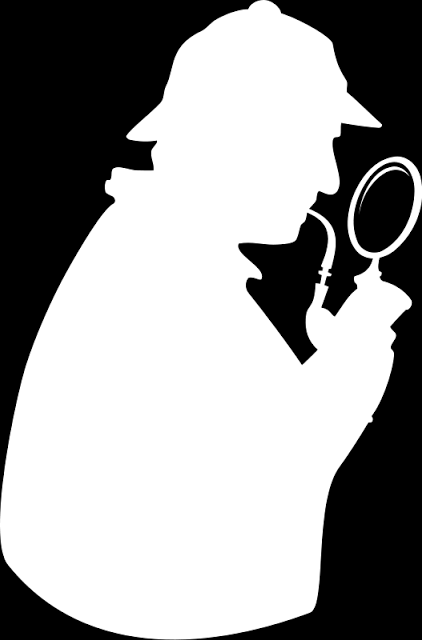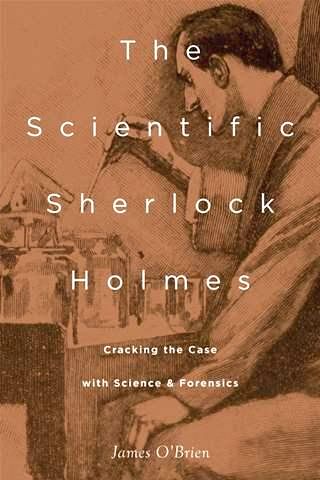Philosophy

by
James F. O’Brien
April 8th, 2013
Oxford University Press
Sir Arthur Conan Doyle claimed that he wrote the Sherlock Holmes stories while waiting in his medical office for the patients who never came. When this natural teller of tales decided to write a detective story, he borrowed the concept of a cerebral detective from Edgar Allan Poe, who had “invented” the detective story in 1841 when he wrote The Murders in the Rue Morgue. So, in 1887, the brilliant Holmes debuts in A Study in Scarlet. The second Holmes story, The Sign of the Four, is a rewrite of The Murders in the Rue Morgue (1841). Instead of an Orangutan scaling the unscaleable wall and killing the occupant, Doyle uses Tonga, a pygmy from the Andaman Islands to do the job. The third Holmes story, A Scandal in Bohemia, is a rewrite of Poe’s The Purloined Letter. Instead of seeking the Queen of France’s letter, Holmes must find the King of Bohemia’s incriminating photograph.
Doyle wrote a total of 60 Holmes stories and most of the time Sherlock Holmes and Dr. Watson share lodgings in London. Their very lives reflect the superior English education of that era. At 221b Baker Street the conversation is full of mathematical terms such as surds, conic sections, and the fifth proposition of Euclid. We hear about astronomy too: the obliquity of the ecliptic and the dynamics of asteroids. But Holmes is a chemist at heart. Before Watson even meets Holmes he is told by Young Stamford that Holmes “is a first-class chemist.” Almost every one of the tales contains a reference to some chemical. They range from elements like zinc (Zn) and copper (Cu), to industrial chemicals such as sulphuric acid and the dye Tyrian purple. Of course numerous poisons are mentioned, and several are used.
Watson, the narrator, makes Holmes’s devotion to chemistry very clear. While still a student Holmes spent his Christmas break working on experiments in organic chemistry. Holmes had a “chemical table” in their Baker Street flat. On at least one occasion the odors drove Watson to leave the premises. Another time Holmes suspended working on a case because he had “a chemical analysis of some interest to finish.” Would that Sherlock had solved more cases by chemical means, but still the chemist finds much of interest in nearly every one of the 60 tales.
Arthur Conan Doyle was also at the forefront of forensic innovation. Holmes used fingerprints (before Scotland Yard), footprints, dogs, document analysis (before the FBI started its document section), and cryptology. After Doyle’s death it was noted that,
“Poisons, handwriting, stains, dust, footprints, traces of wheels, the shape and position of wounds, the theory of cryptograms — all these and other excellent methods which germinated in Conan Doyle’s fertile imagination are now part and parcel of every detective’s scientific equipment.”
There is more science in the first half of the “Canon” and its prevalence has clearly affected the popularity of the individual tales. The Holmes stories have been ranked several times and the results consistently support the idea that those stories which contain science are preferred over those that do not. Even Conan Doyle’ own rankings agree with this. In 1927 he listed his favorite stories — 19 of them. Fifteen were from the first 30 stories and only four from the last 30. Other rankings yield the same result. In 1959 The Baker Street Journal listed the results of a poll which named the ten best and the ten worst Sherlock Holmes tales. Eight of the ten best were from the first half; while nine of the ten worst were from the last half. Sherlock Holmes was, and is, a detective that every scientist can love.

- Darwin - Evolution Of A Madman
From the producers of Sherlock Holmes comes the incredible story of a bad-ass detective of nature whose insightful observations and unorthodox conjectures would one day change the world, threaten the church, kill God, get his first cousin knocked up,...
- A Swiss Doyle
Sir Arthur Conan Doyle May 22nd, 1859 to July 7th, 1930 Scottish novelist, physician, spiritualist. His fictional detective, Sherlock Holmes, emulates the scientist, diligently searching through data and to make sense of it. "It is a capital mistake...
- Oxford
Oxford I said no more felines, but that cannot be despite the strong mourning for Bruno. However, on the evening of June 12th during severe weather "Oxford" was delivered as a result of saving him from kind people who were forced to reduce their feline...
- "the Lost World" [1925]--silent Film Of Significance
This is the first film adaptation of Sir Arthur Conan Doyle's [Sherlock Holmes] classic novel about a land where prehistoric creatures still roam. It stars Bessie Love, Lewis Stone, Wallace Beery, Lloyd Hughes, and Alma Bennett directed by Harry O....
- King Kong And The Missing 35mm Movie Camera
Ask Auguste Dupin or Sherlock Holmes and they would agree that logical deduction [a part of doing good science] is most useful and assisted them in solving difficult cases. For some fun, follow the mystery of the missing 35mm camera that was used in the...
Philosophy
Sherlock Holmes and chemistry

"Sherlock Holmes knew chemistry"
by
James F. O’Brien
April 8th, 2013
Oxford University Press
Sir Arthur Conan Doyle claimed that he wrote the Sherlock Holmes stories while waiting in his medical office for the patients who never came. When this natural teller of tales decided to write a detective story, he borrowed the concept of a cerebral detective from Edgar Allan Poe, who had “invented” the detective story in 1841 when he wrote The Murders in the Rue Morgue. So, in 1887, the brilliant Holmes debuts in A Study in Scarlet. The second Holmes story, The Sign of the Four, is a rewrite of The Murders in the Rue Morgue (1841). Instead of an Orangutan scaling the unscaleable wall and killing the occupant, Doyle uses Tonga, a pygmy from the Andaman Islands to do the job. The third Holmes story, A Scandal in Bohemia, is a rewrite of Poe’s The Purloined Letter. Instead of seeking the Queen of France’s letter, Holmes must find the King of Bohemia’s incriminating photograph.
Doyle wrote a total of 60 Holmes stories and most of the time Sherlock Holmes and Dr. Watson share lodgings in London. Their very lives reflect the superior English education of that era. At 221b Baker Street the conversation is full of mathematical terms such as surds, conic sections, and the fifth proposition of Euclid. We hear about astronomy too: the obliquity of the ecliptic and the dynamics of asteroids. But Holmes is a chemist at heart. Before Watson even meets Holmes he is told by Young Stamford that Holmes “is a first-class chemist.” Almost every one of the tales contains a reference to some chemical. They range from elements like zinc (Zn) and copper (Cu), to industrial chemicals such as sulphuric acid and the dye Tyrian purple. Of course numerous poisons are mentioned, and several are used.
Watson, the narrator, makes Holmes’s devotion to chemistry very clear. While still a student Holmes spent his Christmas break working on experiments in organic chemistry. Holmes had a “chemical table” in their Baker Street flat. On at least one occasion the odors drove Watson to leave the premises. Another time Holmes suspended working on a case because he had “a chemical analysis of some interest to finish.” Would that Sherlock had solved more cases by chemical means, but still the chemist finds much of interest in nearly every one of the 60 tales.
Arthur Conan Doyle was also at the forefront of forensic innovation. Holmes used fingerprints (before Scotland Yard), footprints, dogs, document analysis (before the FBI started its document section), and cryptology. After Doyle’s death it was noted that,
“Poisons, handwriting, stains, dust, footprints, traces of wheels, the shape and position of wounds, the theory of cryptograms — all these and other excellent methods which germinated in Conan Doyle’s fertile imagination are now part and parcel of every detective’s scientific equipment.”
There is more science in the first half of the “Canon” and its prevalence has clearly affected the popularity of the individual tales. The Holmes stories have been ranked several times and the results consistently support the idea that those stories which contain science are preferred over those that do not. Even Conan Doyle’ own rankings agree with this. In 1927 he listed his favorite stories — 19 of them. Fifteen were from the first 30 stories and only four from the last 30. Other rankings yield the same result. In 1959 The Baker Street Journal listed the results of a poll which named the ten best and the ten worst Sherlock Holmes tales. Eight of the ten best were from the first half; while nine of the ten worst were from the last half. Sherlock Holmes was, and is, a detective that every scientist can love.

The Scientific Sherlock Holmes: Cracking the Case with Science and Forensics
by
James O'Brien
ISBN-10: 0199794960
ISBN-13: 978-0199794966
by
James O'Brien
ISBN-10: 0199794960
ISBN-13: 978-0199794966
- Darwin - Evolution Of A Madman
From the producers of Sherlock Holmes comes the incredible story of a bad-ass detective of nature whose insightful observations and unorthodox conjectures would one day change the world, threaten the church, kill God, get his first cousin knocked up,...
- A Swiss Doyle
Sir Arthur Conan Doyle May 22nd, 1859 to July 7th, 1930 Scottish novelist, physician, spiritualist. His fictional detective, Sherlock Holmes, emulates the scientist, diligently searching through data and to make sense of it. "It is a capital mistake...
- Oxford
Oxford I said no more felines, but that cannot be despite the strong mourning for Bruno. However, on the evening of June 12th during severe weather "Oxford" was delivered as a result of saving him from kind people who were forced to reduce their feline...
- "the Lost World" [1925]--silent Film Of Significance
This is the first film adaptation of Sir Arthur Conan Doyle's [Sherlock Holmes] classic novel about a land where prehistoric creatures still roam. It stars Bessie Love, Lewis Stone, Wallace Beery, Lloyd Hughes, and Alma Bennett directed by Harry O....
- King Kong And The Missing 35mm Movie Camera
Ask Auguste Dupin or Sherlock Holmes and they would agree that logical deduction [a part of doing good science] is most useful and assisted them in solving difficult cases. For some fun, follow the mystery of the missing 35mm camera that was used in the...
